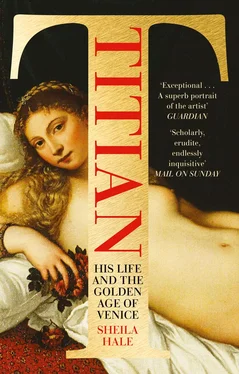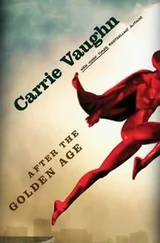The air of the dark, dusty, busy colour shops was spiced with warmed vinegar in which lead and copper were steamed to produce lead white and verdigris. Their shelves and backrooms were piled with dried insects, herbaceous perennials, metals and minerals: yellow orpiment and orange realgar, which was also used for making fireworks; cinnabar and the tiny bodies of female insects imported from India that produced the finest crimson glazes; malachite from Hungary; earth colours from Siena and Umbria; softwood pitch, a by-product of charcoal making, used for brown glazes. Of the pigments manufactured locally, Venice was well known for its vermilion, its lead-tin yellow and especially its lead white, which was exported to England in such quantities that it was known there as Venetian white. Venetians used it as a priming coat, greyed or browned by the addition of particles of charcoal or lamp black, for modelling or impasto highlights, or mixed with other pigments to intensify their colour and enhance their reflective properties.
The most precious pigments were sold by the ounce or half-ounce. Venice had a virtual monopoly on lapis lazuli. The most expensive artists’ material after gold, lapis lazuli was mined in the mountainous caves of Badakhshan (in present-day Afghanistan), which were accessible for only a few months in the year. The extraction of ultramarine – oltremare di Venezia – from lapis lazuli was a laborious procedure, which involved hammering and kneading the ground stone with wax, resins and oils, which was then soaked in water for several days until the precious pigment floated to the surface. Lapis was sometimes used in combination with azurite, which was known as German blue because the best-quality crystals were mined in Germany, where they were ground and graded before export to Venice to be made into pigment, some of which was returned across the Alps.
Dyestuffs used for glass and textiles coloured the lakes, which, applied over lighter opaque layers of pigment, act like coloured filters, enriching tone and adding to the sense of light emerging from within the painting. Many years after Titian had run errands for Sebastiano Zuccato he sent to Venice from Germany, where he was working on a portrait of the emperor Charles V, for half a pound of red lake, ‘so fiery and splendid in its madder colour that by the side of it the crimson of velvet and silk become less beautiful’. (Titian, in other words, would outshine the most precious fabrics by painting with the same dyestuffs – madder was one of the most costly – in which they had been dipped.) By mid-century there were some twenty vendecolori, some of them also providing ready-mixed colours, in and around the Rialto. It is possible that Titian’s fine portrait of a man with a palm and a box of colours (Dresden, Gemäldegalerie), dated 1561,5 is one of them, displaying the high-quality ready-to-use pigments that they increasingly prepared in their shops.
Nevertheless, although it was often said, by Leonardo among others, that colours are beautiful in themselves, it was the handling of pigments, not the use of brilliant colours, that set the greatest artists apart. Dolce objected to those who praised Titian as a colourist, pointing out that if that was all there was to him many women would be his equals. In the seventeenth century Marco Boschini, a Venetian poet, painter, engraver and art dealer, attributed to Titian the remark that a painter needs only three colours: white, black and red. But it takes time to understand how colours work together. The implication for those who knew their Pliny was that Titian was even more skilled at mixing colours than Apelles6 and the other ancient Greek painters, whose palettes were supposedly limited to four colours: white, black, red and yellow.
Titian’s practice of superimposing over opaque body colour layer upon layer of transparent glazes and semi-opaque scumbles – veils of paint that create tonal unity, and a cool, hazy, subdued effect when painted over a darker underlayer – would intrigue and inspire some of the greatest painters of successive centuries. Unfortunately, however, glazes and scumbles are subject over time to discolouration, abrasion and often to clumsy restoration. In some cases cleaning has stripped away centuries of accumulated dirt to reveal something closer to Titian’s original intentions. Too often, alas, he has been compromised to a greater or lesser extent by the loss of some of the paint that made his pictures, in the eyes of his contemporaries, not just stupendous but miraculous.
Once he had qualified as a master painter, probably around 1506, Titian joined the painters’ guild and later served on its board. Membership of the guild, the oldest and most conservative of its kind in Italy, was compulsory; and although it was small and poor it controlled everything from technical standards and the size of studios to the length of holidays. It provided security for its members, who were expected to look after one another in difficult times, and was highly protectionist. Albrecht Dürer, although welcomed by Venetian society, was fined by the guild for practising painting in Venice. The guild did not represent figure painters alone but also textile designers, miniaturists, gilders and painters of playing cards, stage sets, furniture, shields, wheels, bulkheads and barges, saddles and banners (the gilding and painting of embossed leather was a highly prized speciality). A Venetian college of figure painters was not founded until the seventeenth century; nor, until the eighteenth century, was there a Venetian academy that represented both painters and sculptors. Renaissance Venice, unlike Florence, never produced a painter who was also a sculptor, possibly because Florentine artists often began their training as goldsmiths, which could take them either way, while Venetian painters developed in isolation from the other arts.
Painting in any case was the art that most appealed to the Venetian taste for surface decoration. ‘Is there a man, finally,’ asked Dolce, ‘who does not understand the ornament that painting offers to any object at all’:
For though their interior walls be dressed in extremely fine tapestries, and though the chests and tables be covered with most beautiful cloths, both public and private buildings suffer a marked loss of beauty and charm without some painting to ornament them. Outside, too, the façades of houses and palaces give greater pleasure to the eyes of other men when painted by the hand of a master of quality than they do with incrustations of white marble and porphyry and serpentine embellished with gold.
Decorative objects were usually more highly valued in inventories and wills than easel paintings, which are often identified in surviving documents by their subjects or by the value of their frames rather than by the names of the artists who painted them – a habit that has created difficulties for art historians searching for attributions and dates, and which may conceal the names of artists whose works are now hesitantly given to those painters whose names we do happen to know. The problem is exacerbated by the similarities between the paintings of Giorgione and those of the young Sebastiano Luciani and Titian, now the starring names of the first decade of the century, who may well have shared assistants. Artists better known today for their easel paintings and altarpieces were in any case not above turning their hands to decorative jobs. Several panels of scenes from Ovid, probably painted on domestic storage chests, have been attributed to the young Titian,7 although the only widely accepted candidate is the damaged but delightful Orpheus and Eurydice (Bergamo, Accademia Carrara). Frescoing the façades and courtyards of houses, sometimes for a special occasion such as a wedding or the visit of a foreign dignitary, offered painters, including Giorgione and Titian, the opportunity to work on a large scale and to proclaim their talents for all the world to see, at least for as long as the frescos lasted in the humid saline air of the lagoon, polluted as it was even then by industrial fumes.
Читать дальше












